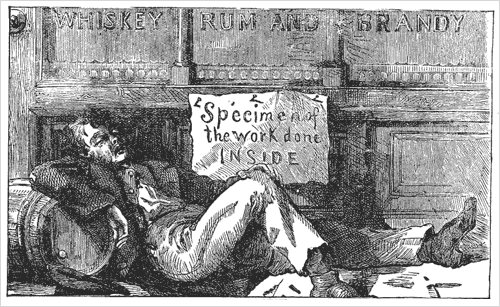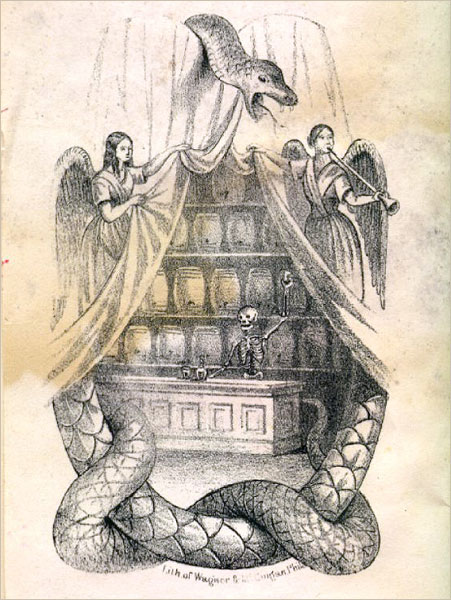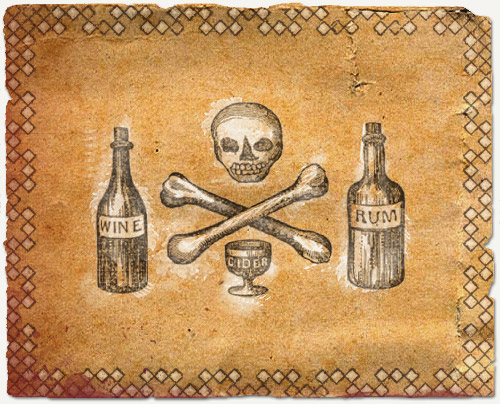It is said that in America, prior to the Revolution and prior to urbanization, alcohol consumption, as a general rule, was kept to what was then considered acceptable levels through informal social control in the home and in the community. After the Revolution and urbanization the country saw an increase in poverty, unemployment, and crime, much of which was blamed on the relaxation of social control over alcohol, and the corresponding rise of drunkenness. In hopes of reasserting that social control over the “demon rum” temperance societies began popping up across the Northeast. By 1830 there were 2,220 such temperance societies in the United States, each wielding an arsenal of tracts, leaflets, broadsides, pledges, songs, plays, and illustrations meant to scare, guilt, and bully men back into sobriety…. and that’s a lot of printed matter.
Quote: “The earliest printed works of the movement focused on alcohol’s bad influence on health, including the immediate effects of drunkenness (like vomiting and headache) and the perceived long-term effects of chronic drinking (like delirium tremens, spontaneous human combustion, madness, and death). When the movement blossomed in the early 1830s, medical arguments made up a powerful element in encouraging temperance.” -Ardent Spirits
Meanwhile, since the headaches and vomiting and madness and spontaneous combustion didn’t seem potent enough deterents on their own, other works focussed instead on the moral and religious ramifications of strong drink. “You’ll destroy your family, you’ll lose your home, you’ll burn in the bad place!” It was a potent logos/pathos one-two punch of rhetoric which, just prior to the Civil War, managed to win over no less than 1,500,000 proponents.
Below I present a small cross section of the rich and varied cornucopia of printed ephemera which has been passed down to us from our temperate forbearers. Have a look.








What follows is an excerpt of the text A Study In Faces which accompanied the image above:
“What a bright earnest face this boy had! Just such a face as everybody likes to see. Many years ago a great artist wanted to make an attractive picture for his studio and he chose such a face. He called it “Innocence,” and you might label this boy with the same word.
Now look at the other face. What is attractive about it? Not a feature to admire, but everything to make one turn away in disgust. One would almost be afraid to be in the company of a man with such a face, for the character is shown in the face and if the boy is a picture of innocence, the man is a picture of all that is vile and hateful.
Now compare the two faces before you. The features are similar yet so different. Both represent the same face, but what a change!
The artist has given you a glimpse of the way in which thousands of bright, clean boys have been first fascinated and then defiled and ruined. No one who learns to like wine, beer, cider, any alcoholic drink can be sure of escaping such a fate, for nothing tends more strongly to defile human beings and make them unclean forever than alcohol.”


















With the outbreak of the Civil War interest in temperance (understandably) cooled. People presumably had more immediate and important concerns. That fact alone says something about the temperance movement on the whole I’d have to say. It would be a generation before the general levels of comfort and boredom made allowances for a moral outrage potent enough to usher in a legislated country-wide prohibition. We all know how that went over.
And today? What of the Temperance movement? Well, today, all these morally blighted years later, a vestige of those glory days of temperance does in fact remain, visible for all to see.
Behold!

Well, just barely visible for all to see, but it’s there! Congratulations righteous forbearers.
Hope you enjoyed.
For more on the temperance movement in America see the following-
Ardent Spirits
Alcohol, Temperance, & Prohibition at Brown University.
Alcohol and Crime
The Temperance Archive
Alcoholism and the Temperance Movement in Early American Folk Art
Temperance & Prohibition at Ohio State
The Anti-Saloon League
Temperance Movements in the Catholic Encyclopedia
A History of Alcohol Prohibition at the Drug Library
Drinking in America: a History.
Note: nearly all of the images above were found through The Library of Congress “American Memory” site.


